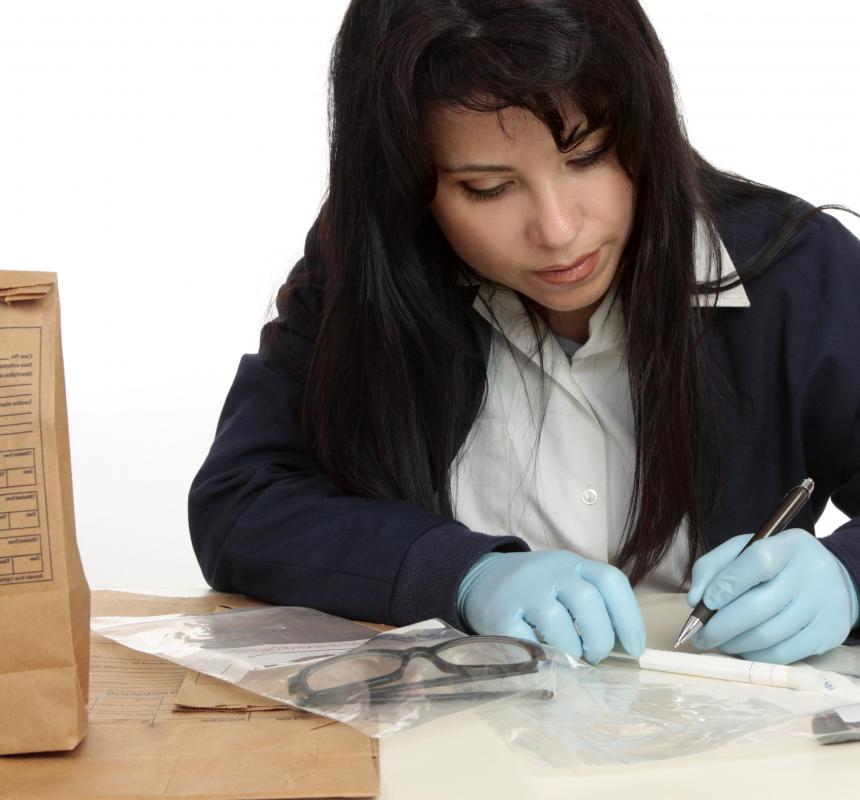At WiseGEEK, we're committed to delivering accurate, trustworthy information. Our expert-authored content is rigorously fact-checked and sourced from credible authorities. Discover how we uphold the highest standards in providing you with reliable knowledge.
What is DNA Profiling?
DNA profiling is a technique in which a sample of DNA is run through a laboratory assay to generate information about it, looking specifically for DNA which could identify the source of the sample, or be used as a base of comparison between two samples. It can utilize the DNA of someone who is unknown, or the DNA of someone who is known, and it can be used in a variety of ways, from law enforcement to genealogy.
This technique relies on the presence of what are known as short tandem repeats (STRs) in the genetic code of every organism on Earth. These repetitive strings of DNA are non-coding, meaning that they do not contribute to the expression of an organism's genome, but they can provide valuable information about an individual, because they tend to be very unique. DNA profiling is sometimes referred to as DNA fingerprinting for this reason, referencing the idea that finding an exact match between STRs in two different people would be very rare under most circumstances.

Several techniques can be used to extract the DNA and look at the areas of interest. Usually, DNA profiling relies on a reference sample, such as known DNA from a missing person, or DNA from a crime scene, with a comparison sample being taken from a person of interest to look for a match. It is also sometimes used to look for indications that two people are related, as people who are related can share some STRs in their DNA, although a lack of a conclusive match does not necessarily mean that two people are not related.

The profiling process is accomplished by a technician who has been trained to work with a wide variety of samples, and to look for specific areas for comparison. DNA profiling can also examine similar alleles, areas of the genome which code for particular proteins, although this process can be less reliable, as many people share alleles.
DNA typing, as it is sometimes known, debuted in the 1980s, and by the late 1990s, it was in widespread use. A number of misconceptions also arose about the process: fans of crime shows, for example, may be under the impression that DNA profiling can be done in minutes, and that samples of DNA are always easy to work with. In fact, some samples can be very difficult to work with, and the process of DNA profiling can take weeks or months, especially at a busy lab. The process is also not totally infallible, as samples can be damaged or contaminated, resulting in false negatives or positives.
AS FEATURED ON:
AS FEATURED ON:

















Discussion Comments
SauteePan- I heard that many juries are now attuned to the subject of DNA testing because of many popular television shows.
These topics used to be considered boring by juries, but now that there's increasing interest in the subject.
A great book about forensic DNA is,“Forensic DNA, Profiling Protocols” by Patrick Lincoln and Jim Thomson. It analyzes state of the art in DNA analysis and profiling methods.
It looks at various methods of data collection from laboratories all over the world. It reviews the best case studies used.
Suntan12-I also wanted to say that DNA profile analysis is conducted in order to solve crimes.
Sometimes in some rare situations, DNA testing can absolve a person that is charged with a crime that is actually innocent too.
DNA profiling is a godsend for people in that situation. When DNA blood is collected, it can sometimes break down and not be as accurate as other methods of DNA collection.
The blood sample has to be almost perfect, which is not always possible. These are great uses of DNA profiling.
The uses the main profiling is quite vast. DNA profiling uses include DNA paternity testing as well as forensic DNA analysis for crime solving purposes.
DNA paternity tests are almost 100% accurate because they know that certain genetic codes repeat in a very unique fashion.
Once they find these genetic patterns than they can determine the paternity of the child. Many men deny paternity but once the definitive results are in, it is very difficult to argue against.
This also resolves a lot of issues for men and women in regards to child support.
Post your comments